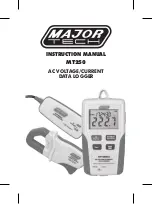
Scalar Speed:
•
Mean Speed Scalar – This is the scalar wind speed, not taking direction
into account. The scalar average of 10mph for an hour and 20mph for an
hour is 15mph, regardless of changing direction.
Scalar Direction:
•
Mean Direction Unit – This is the wind direction (in degrees) not weighted
for wind speed. Here, the average of 10mph at 0
°
with 20mph at 90
°
is
45
°
.
Vector Speed:
•
Mean Magnitude Wind – This is the vector average of the wind speed
which takes direction into account. Here, the average of 10mph at 0
°
for 1
hour and 20mph at 180
°
for 1 hour is negative 5mph.
Vector Direction:
•
Mean Direction Wind – This is the wind direction (in degrees) weighted
for wind speed. Here, the average of 10mph at 0
°
with 100mph at 90
°
is
84
°
.
Please note that the
raw
reading (the reading before slope, offset, and equation
processing are applied) is not available for wind measurements.
Digital
Use the setting
Digital Type
to tell MONITOR what kind of sensor is connected.
Digital Type
MONITOR supports the following digital types:
o
Input F (terminal 20)
o
Input G (terminal 21)
o
Frequency (terminal 12)
o
Period (terminal 12)
Input F
and
Input G
are discrete inputs. They will read either 0 or 1.
Slope
and
Offset
can be applied.
Frequency
and
Period
share the same
input
(terminal 12). Additionally, the RM
Young sensor type requires the use of this input too. Only one of these should be
setup at a time.
Frequency
will have MONITOR sample the input for 750ms. It will provide a
result that is the average frequency of the input during that time span. If no
signals are noticed on the input during the time, the measurement is considered
bad.
When
Period
is the chosen type, MONITOR will watch the input line for up to 10
seconds. MONITOR stops watching as soon as one wave period is noticed on the
input. If the input signal does not transition during this time, the measurement is
considered bad.
24













































